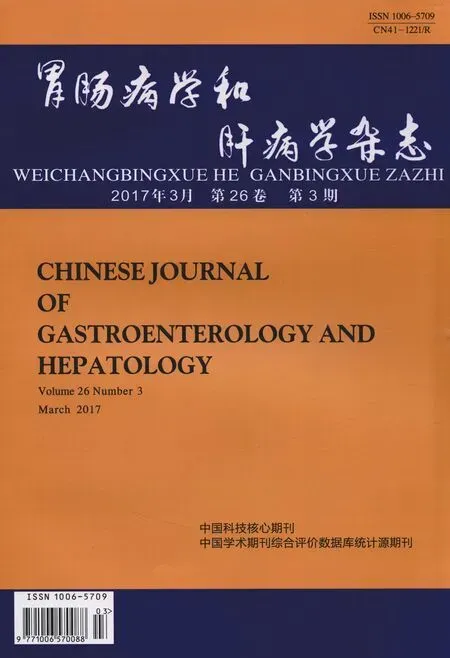炎症性肠病药物治疗的肿瘤风险
2017-03-08张慧敏
张慧敏,金 梦,杨 红
中国医学科学院 北京协和医学院 北京协和医院消化内科,北京 100730
炎症性肠病药物治疗的肿瘤风险
张慧敏,金 梦,杨 红
中国医学科学院 北京协和医学院 北京协和医院消化内科,北京 100730
近年来炎症性肠病(inflammatory bowel disease,IBD)治疗相关的肿瘤风险越来越受到关注,关于免疫抑制剂及生物制剂对肿瘤的影响,不同研究报道结果尚不一致。本文就应用免疫抑制剂和生物制剂可能带来的肿瘤风险及预防和筛查的策略研究进展作一概述。
炎症性肠病;治疗;肿瘤
炎症性肠病(inflammatory bowel disease,IBD)是一种慢性的非特异性胃肠道炎症性疾病,包括克罗恩病(Crohn’s disease,CD)和溃疡性结肠炎(ulcerative colitis,UC),其治疗药物包括氨基水杨酸制剂、激素、免疫抑制剂、生物制剂等。自从免疫抑制剂和生物制剂引入IBD治疗以后,患者外科手术率明显降低,文献[1]报道UC手术率降低4%、CD手术率降低25%。然而患者在获得药物治疗收益的同时,药物的不良反应也日益受到医师和患者的关注,主要不良反应包括骨髓抑制、肝肾功能损伤、肿瘤风险等。而药物诱发肿瘤风险的几率有多少,并且哪一种药物、什么剂量、多长时间会诱发肿瘤的风险增加,这些都是医师和患者极其关注的临床问题。本文将着重对应用免疫抑制剂和生物制剂可能带来的肿瘤风险及预防和筛查的策略作一概述。
1 免疫抑制剂
1.1 嘌呤类药物临床上常用的有硫唑嘌呤(Azathioprine,AZA)和6-巯基嘌呤(6-mercaptopurine,6-MP)。它们是IBD患者维持缓解的主要药物。但越来越多的研究发现嘌呤类药物的长期应用可能会增加恶性肿瘤的风险,文献[2-4]报道主要包括血液系统肿瘤、皮肤癌、泌尿系统肿瘤及宫颈癌。
1.1.1 血液系统肿瘤:文献报道AZA或6-MP有诱发淋巴瘤的风险。法国一项队列研究[2]表明接受AZA治疗的IBD患者更容易患淋巴瘤(HR 5.28,95%CI:2.01~13.9),并且年龄越大、IBD患者病程越长,淋巴瘤发病率越高,停止AZA应用则可以逆转肿瘤发生风险。而关于AZA的用药时间与淋巴瘤之间关系,2013年一项纳入36 891例UC患者的回顾性分析[3]显示:在AZA治疗的第1、2、3、4、>4年中,淋巴瘤的发病率分别为9/100人年、16/100人年、16/100人年、50/100人年、89/100人年,结果提示AZA的疗程越长,淋巴瘤风险越高,当AZA疗程>4年时,淋巴瘤风险明显增加。Beigel等[4]研究也显示AZA疗程>4年使淋巴瘤发生的风险显著增加10倍左右(P=0.0005)。目前关于AZA剂量与淋巴瘤的关系研究较少;但一项动物模型中的研究[5]结果显示AZA剂量与淋巴瘤的发生风险呈正相关。
另外AZA引起淋巴瘤的风险与EBV感染是否有关目前尚难得出结论,主要由于大部分嘌呤类药物导致淋巴瘤风险的文章中没有分析EBV感染的作用。有一项研究[6]显示经AZA治疗的IBD患者中,5/7淋巴瘤为EBV感染相关;而未经AZA治疗的IBD患者,1/11淋巴瘤为EBV感染相关,差异有统计学意义(P=0.01),并且免疫抑制剂的停用可以使EBV相关的淋巴瘤自发地得到缓解,原因考虑与AZA抑制了免疫细胞对EBV病毒清除相关。但此研究共纳入18例患者,例数较少,故EBV感染与AZA治疗相关淋巴瘤之间的关系仍需进一步研究。
当然也有研究表明AZA/6-MP应用并未增加淋巴瘤的发生风险,Connell等[7]的一项前瞻性研究显示,755例IBD患者分别予AZA治疗(2 mg/kg)治疗2 d~15年,随访2周~29年,共发生2例宫颈癌,无淋巴瘤发生。Warman等[8]在一项回顾性研究中共纳入410例IBD患者,均予6-MP治疗20年,结果发生3例淋巴瘤、2例白血病,与非6-MP治疗者比较差异无统计学意义。2015年ECCO指南[9]也提出接受AZA治疗的IBD患者,淋巴瘤的发生风险增加,而停用AZA则可逆转此风险。
除淋巴瘤之外,嘌呤类药物也会增加急性髓系白血病(acute myeloid leukemia,AML)的发生风险,有文献[10]表明既往6-MP应用史增加了AML的发病率(IR 6.98,95%CI:1.44~20.36),正在使用6-MP的患者AML发病率未增加(SIR 1.54,95%CI:0.05~8.54)。但此研究对正在使用6-MP的患者共随访35个月,有可能AML的风险尚未出现,故这部分结论需延长随访时间进一步评估。
1.1.2 其他肿瘤:嘌呤类药物可能有诱发皮肤癌、宫颈癌及泌尿系统肿瘤的风险。多项研究[11-12]显示应用AZA的IBD患者患非黑色素皮肤癌(non-melanoma skin cancer,NMSC)风险增加。法国一项前瞻性队列研究[11]共纳入19 486例IBD患者,结果显示与未使用AZA患者相比,正在接受AZA治疗的患者及既往接受过AZA治疗的患者NMSC发生率明显升高(前者HR 5.9,95%CI:2.1~16.4;后者HR 3.9,95%CI:1.3~12.1),且患者年龄每增加1岁,NMSC发病率增加1.08倍。目前认为AZA导致皮肤癌的机制主要有以下两点:(1)AZA增加了皮肤对紫外线辐射的易感性,可导致DNA的突变及过氧化,进而导致皮肤癌的发生;(2)在没有阳光暴露的情况下,AZA也可以导致抑癌基因PTCH基因的突变,PTCH基因的突变可以导致Hedgehog信号通路发生调节异常,进而导致音猥因子(sonic hedgehog,SHH)信号组成性的过表达,这与皮肤基底细胞癌的发生相关。
在器官移植的患者中,AZA的应用可以增加人乳头状瘤病毒(human papillomavirus,HPV)相关宫颈癌的发生[13];但IBD患者使用AZA是否会增加宫颈癌的风险文献报道结果不一。一项病例对照研究[14]指出免疫抑制剂(包括AZA)的使用可以增加宫颈癌的发病率(OR=1.5),也有研究[15]指出AZA并未增加肿瘤发病率。AZA导致宫颈癌的发生多与HPV感染相关,其机制可能与其削弱T淋巴细胞对HPV感染的抵抗能力相关。另外,关于AZA对泌尿系肿瘤的研究较少,有文献[16]报道与未使用AZA患者相比,应用AZA的患者泌尿系肿瘤发生率增加2.6倍,其中6/7为肾癌。
总之,嘌呤类药物增加了IBD患者的肿瘤发生率。因此,在接受AZA治疗时需谨慎考虑,尤其是在老年男性患者中,需根据体质量调整用药物剂量,必要时可检测巯基嘌呤甲基转移酶活性或基因型,定期检测其不良反应;另外AZA/6-MP治疗疗程不宜超过4年,尤其对于长期缓解的患者,因为此类患者的疾病复发率较低。
2 其他免疫抑制剂
目前关于其他免疫抑制剂如甲氨蝶呤、环孢素等对IBD患者肿瘤发生风险的影响研究尚少。研究表明[17]类风湿关节炎患者应用甲氨蝶呤治疗后,黑色素瘤的发病率增加3倍,但并未增加淋巴瘤及NMSC的发生风险。与普通人群相比,使用环孢素的器官移植患者黑色素瘤的发病率也明显升高[18]。但这些免疫抑制剂对IBD患者引起肿瘤的风险有待进一步研究。
3 生物制剂
对激素和免疫抑制剂治疗无效、激素依赖或不能耐受免疫抑制剂治疗的IBD患者,可采用生物制剂治疗。目前临床常用的生物制剂为抗TNF-α制剂,随着其广泛应用,生物制剂的不良反应尤其是患肿瘤的风险也越来越受到关注。在儿童患者中,FDA的数据表明[19]英夫利昔治疗的患者约66/100 000发生恶性肿瘤(背景患病率为16.8/100 000),其中44/100 000为淋巴瘤(背景患病率为2.4/100 000),其他肿瘤包括白血病、黑色素瘤和实体瘤;但因患者数量有限并合并使用免疫抑制剂,尚不能完全确定英夫利昔单抗与肿瘤发生之间相关性的强度。在成人肿瘤方面[20],目前文献表明生物制剂并未增加淋巴瘤发病率;而在对皮肤癌的影响方面,目前尚无统一意见:一项纳入108 579例IBD患者的队列研究[21]表明,生物制剂增加了黑色素瘤发病率(OR=1.88,95%CI:1.08~3.29),并未增加患NMSC的风险;但2014年一项Meta分析[22]显示,与安慰剂组相比,抗TNF-α治疗未增加患皮肤癌风险。具体的结论仍需进一步的研究。对于生物制剂使用,目前推荐意见如下:对于有淋巴瘤病史的患者,禁用英夫利昔单抗;对于有肿瘤前期病变者生物制剂选择应慎重;实体恶性肿瘤必须已经治疗且至少有5年缓解期方可使用;在抗TNF治疗过程中,对于有肿瘤发生高风险及肿瘤既往史患者,应密切监测恶性肿瘤的相关临床征象。
4 肿瘤的预防与筛查
IBD患者中免疫抑制剂或生物制剂的使用均可能增加肿瘤发生的风险,故需对高危人群进行定期筛查和预防。
文献[23]报道淋巴瘤的高危人群为年龄<30岁的男性或>50岁的患者,治疗前需与患者充分交代肿瘤风险,在<35岁男性患者中,应避免AZA联合抗TNF-α治疗超过2年。皮肤癌的高危人群有[24-25]:老龄男性、吸烟、日光暴晒多、日光灼伤史、白种人、皮肤癌家族史等,建议对于使用AZA或抗TNF-α制剂的患者需每年进行皮肤检查,同时避免过度日光暴晒。发病年龄<20岁的女性、吸烟、病变广泛、长期口服避孕药是宫颈癌的高危人群[26-27],在免疫抑制的患者中需每年行宫颈刮片,同时建议在9~26岁患者中接种HPV疫苗。
总之,IBD是慢性病程的疾病,诱导缓解和维持缓解的治疗对避免复发、改善患者生活质量有很重要的意义。但治疗过程中可能伴发肿瘤风险是临床医师及患者最大的担忧,只有对高危人群进行充分筛查及预防,才能最大减少药物治疗的不良反应,充分发挥其治疗疗效。
[1]Rungoe C, Langholz E, Andersson M, et al. Changes in medical treatment and surgery rates in inflammatory bowel disease: a nationwide cohort study 1979-2011 [J]. Gut, 2014, 63(10): 1607-1616.
[2]Beaugerie L, Brousse N, Bouvier AM, et al. Lymphoproliferative disorders in patients receiving thiopurines for inflammatory bowel disease: a prospective observational cohort study [J]. Lancet, 2009, 374(9701): 1617-1625.
[3]Khan N, Abbas AM, Lichtenstein GR, et al. Risk of lymphoma in patients with ulcerative colitis treated with thiopurines: a nationwide retrospective cohort study [J]. Gastroenterology, 2013, 145(5): 1007-1015, e3.
[4]Beigel F, Steinborn A, Schnitzler F, et al. Risk of malignancies in patients with inflammatory bowel disease treated with thiopurines or anti-TNF alpha antibodies [J]. Pharmacoepidemiol Drug Saf, 2014, 23(7): 735-744.
[5]Bodo S, Svrcek M, Sourrouille I, et al. Azathioprine induction of tumors with microsatellite instability: risk evaluation using a mouse model [J]. Oncotarget, 2015, 6(28): 24969-24977.
[6]Dayharsh GA, Loftus EV Jr, Sandborn WJ, et al. Epstein-Barr virus-positive lymphoma in patients with inflammatory bowel disease treated with azathioprine or 6-mercaptopurine [J]. Gastroenterology, 2002, 122(1): 72-77.
[7]Connell WR, Kamm MA, Dickson M, et al. Long-term neoplasia risk after azathioprine treatment in inflammatory bowel disease [J]. Lancet, 1994, 343(8908): 1249-1252.
[8]Warman JI, Korelitz BI, Fleisher MR, et al. Cumulative experience with short- and long-term toxicity to 6-mercaptopurine in the treatment of Crohn’s disease and ulcerative colitis [J]. J Clin Gastroenterol, 2003, 37(3): 220-225.
[9]Annese V, Beaugerie L, Egan L, et al. European evidence-based consensus: inflammatory bowel disease and malignancies [J]. J Crohns Colitis, 2015, 9(11): 945-965.
[10]Lopez A, Mounier M, Bouvier AM, et al. Increased risk of acute myeloid leukemias and myelodysplastic syndromes in patients who received thiopurine treatment for inflammatory bowel disease [J]. Clin Gastroenterol Hepatol, 2014, 12(8): 1324-1329.
[11]Peyrin-Biroulet L, Khosrotehrani K, Carrat F, et al. Increased risk for nonmelanoma skin cancers in patients who receive thiopurines for inflammatory bowel disease [J]. Gastroenterology, 2011, 141(5): 1621-1628, e1-e5.
[12]Ariyaratnam J, Subramanian V. Association between thiopurine use and nonmelanoma skin cancers in patients with inflammatory bowel disease: a meta-analysis [J]. Am J Gastroenterol, 2014, 109(2): 163-169.
[13]Gutierrez-Dalmau A, Campistol JM. Immunosuppressive therapy and malignancy in organ transplant recipients: a systematic review [J]. Drugs, 2007, 67(8): 1167-1198.
[14]Kane S, Khatibi B, Reddy D. Higher incidence of abnormal Pap smears in women with inflammatory bowel disease [J]. Am J Gastroenterol, 2008, 103(3): 631-636.
[15]Lees CW, Critchley J, Chee N, et al. Lack of association between cervical dysplasia and IBD: a large case-control study [J]. Inflamm Bowel Dis, 2009, 15(11): 1621-1629.
[16]Pasternak B, Svanstrom H, Schmiegelow K, et al. Use of azathioprine and the risk of cancer in inflammatory bowel disease [J]. Am J Epidemiol, 2013, 177(11): 1296-1305.
[17]Buchbinder R, Barber M, Heuzenroeder L, et al. Incidence of melanoma and other malignancies among rheumatoid arthritis patients treated with methotrexate [J]. Arthritis Rheum, 2008, 59(6): 794-799.
[18]Dahlke E, Murray CA, Kitchen J, et al. Systematic review of melanoma incidence and prognosis in solid organ transplant recipients [J]. Transplant Res, 2014, 3: 10.
[19]Diak P, Siegel J, La Grenade L, et al. Tumor necrosis factor alpha blockers and malignancy in children: forty-eight cases reported to the food and drug administration [J]. Arthritis Rheum, 2010, 62(8): 2517-2524.
[20]Caspersen S, Elkjaer M, Riis L, et al. Infliximab for inflammatory bowel disease in Denmark 1999-2005: clinical outcome and follow-up evaluation of malignancy and mortality [J]. Clin Gastroenterol Hepatol, 2008, 6(11): 1212-1217, quiz 1176.
[21]Long MD, Martin CF, Pipkin CA, et al. Risk of melanoma and nonmelanoma skin cancer among patients with inflammatory bowel disease [J]. Gastroenterology, 2012, 143(2): 390-399, e1.
[22]Williams CJ, Peyrin-Biroulet L, Ford AC. Systematic review with meta-analysis: malignancies with anti-tumour necrosis factor-α therapy in inflammatory bowel disease [J]. Aliment Pharmacol Ther, 2014, 39(5): 447-458.
[23]Kotlyar DS, Lewis JD, Beaugerie L, et al. Risk of lymphoma in patients with inflammatory bowel disease treated with azathioprine and 6-mercaptopurine: a meta-analysis [J]. Clin Gastroenterol Hepatol, 2015, 13(5): 847-858, e4; quiz e48-e50.
[24]Euvrard S, Kanitakis J, Claudy A. Skin cancers after organ transplantation [J]. N Engl J Med, 2003, 348(17): 1681-1691.
[25]Magro F, Peyrin-Biroulet L, Sokol H, et al. Extra-intestinal malignancies in inflammatory bowel disease: results of the 3rd ECCO Pathogenesis Scientific Workshop (Ⅲ) [J]. J Crohns Colitis, 2014, 8(1): 31-44.
[26]Singh H, Demers AA, Nugent Z, et al. Risk of cervical abnormalities in women with inflammatory bowel disease: a population-based nested case-control study [J]. Gastroenterology, 2009, 136(2): 451-458.
[27]Hutfless S, Fireman B, Kane S, et al. Screening differences and risk of cervical cancer in inflammatory bowel disease [J]. Aliment Pharmacol Ther, 2008, 28(5): 598-605.
(责任编辑:陈香宇)
Risk of malignancy in the drug therapy for inflammatory bowel disease
ZHANG Huimin, JIN Meng, YANG Hong
Department of Gastroenterology, Peking Union Medical College Hospital, Peking Union Medical College, Chinese Academy of Medical Sciences, Beijing 100730, China
People have paid more and more attention to the tumor risk in the drug therapy of inflammatory bowel disease (IBD). However, studies about the effect of drugs such as immunosuppressants and biological agents on tumor have different results. Here, we will mainly review the tumor risk of immunosuppressants and biological agents and the strategy of prevention and screening.
Inflammatory bowel disease; Treatment; Malignancy
张慧敏,在读硕士,研究方向:炎症性肠病和胰腺。E-mail:huiminzhang91@163.com
杨红,硕士生导师,研究方向:炎症性肠病和胰腺。E-mail:hongy72@163.com
10.3969/j.issn.1006-5709.2017.03.026
R574
A 文章编号:1006-5709(2017)03-0341-03
2016-10-14
